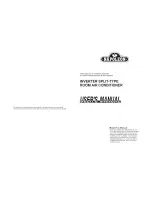
31
English
Ins
tallation
Step 8 Performing the gas leak test
To identify potential gas leaks on the indoor unit, inspect
the connection area of each refrigerant pipe using a leak
detector for R-410A.
Before recreating the vacuum and recirculating the
refrigerant gas, pressurize the whole system with nitrogen
(using a cylinder with a pressure reducer) at a pressure
above 4 MPa in order to immediately detect leaks on the
refrigerant fittings.
Made vacuum for 15 minutes and pressurizing system with
nitrogen.
Insulator
Gas side
Liquid side
Step 9 Insulating the refrigerant pipes
Once you have checked that there are no leaks in the
system, you can insulate the piping and hose.
1.
To avoid condensation problems, place Acrylonitrile
Butadien Rubber separately around each refrigerant pipe.
NOTE
• Always make the seam of pipes face upwards.
2.
Wind insulating tape around the pipes and drain hose
avoiding compressing the insulation too much.
CAUTION
• Be sure to wrap insulation tightly without any gaps.
3.
Finish wrapping insulating tape around the rest of the
pipes leading to the outdoor unit.
4.
The pipes and electrical cables connecting the indoor
unit with the outdoor unit must be fixed to the wall with
suitable ducts.
CAUTION
• Make sure that all refrigerant connection must be
accessible for easy maintenance and detachment.
• Install the insulation not to get wider and use the
adhesives on the connection part of it to prevent
moisture from entering.
• Wind the refrigerant pipe with insulation tape if it is
exposed to outside sunlight.
• Install the refrigerant pipe respecting that the
insulation does not get thinner on the bent part or
hanger of pipe.
• Add the additional insulation if the insulation plate
gets thinner.
a x 3
a
Additional insulation
Refrigerant pipe
insulation
Hanger
Indoor unit
Insulation cover pipe
Insulation pipe
Be sure to overlap the insulation.
No gap
NBR
Содержание AJ NBLDCH Series
Страница 40: ...40 English Installation...











































